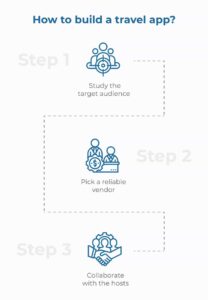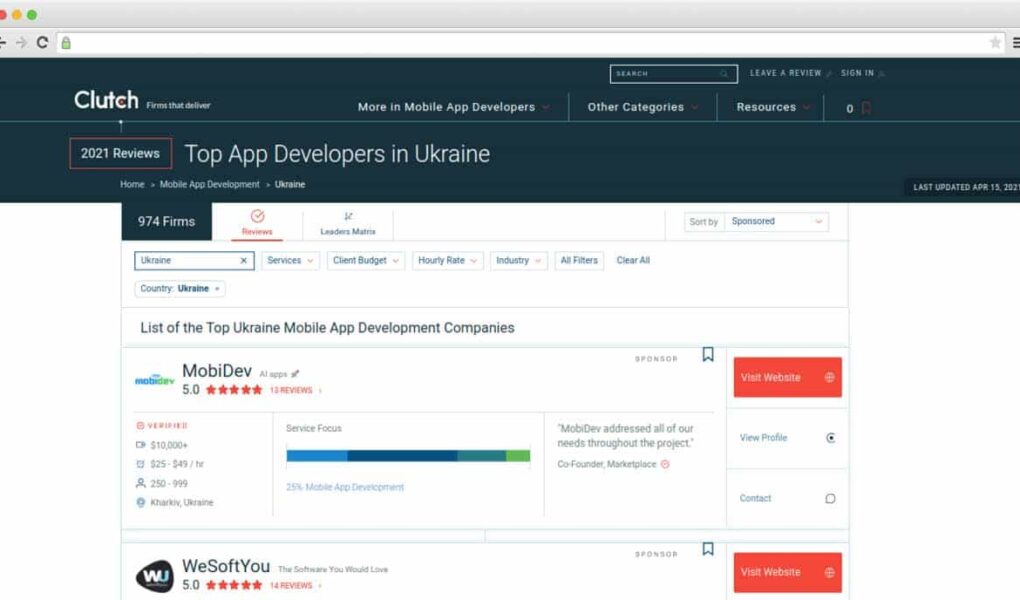Revenue Models, Features, Cost
No trip and its planning are complete without mobile phones’ help. What about the tourism niche, it’s difficult to talk about its relevance these days because of the lockdown situation. So, if you are still thinking about travel app development, you need to draw up the budget, decide on features, and choose the business model accurately.
This article will give you answers to how travel apps generally work, what are the main features, how much money, and what kind of tech stack do you need to create a good travel app.
How do travel apps work
Travel apps provide users with the ability to quickly and easily find the hotels, restaurants, and others they want while on vacation. However, to attract more potential clients, the agencies that create such apps choose an excellent strategy – they fill the tourism apps with content that is useful for tourists. This can be information about exclusive tours, travel guides, reviews of travelers.
What about interaction with the app, the development companies are trying to create a comfortable tool for users with various filtering options, a feedback system, and other useful features. It’ll help users to rent a car, find and check ticket prices, book accommodation easily and quickly. For example, such a giant in the travel app industry as TripAdvisor provides users with the ability to do all these operations in one app.
How to travel apps make money
Let’s consider three models of revenue generation with examples of companies that are kept on the top according to it.
Advertising.
By choosing this model, you can provide relevant advertisements (for hotels, tour operators) or sell advertising space to firms in the travel industry. A good example is the travel app TripAdvisor that makes money by redirecting the clients to third-party sites.
This model doesn’t guarantee a 100% increase in the number of bookings, but it can increase traffic to a hotel page that took the last place.
Commissions.
Compared to large, small hotels have no budget to advertise. Therefore, they turn to sites such as Booking.com so that users can find them here. In turn, Booking.com charges from 10% to 30% commission from each booking.
Merchant Model.
This model is about how the platforms resell previously purchased hotel rooms to guests. A travel app like Expedia uses this model and receives most of the profits from it. Since Expedia rents out rooms in bulk, hotels provide customers with offers at the lowest prices.
Core features of a travel app

To create a good travel app, you should start by developing an MVP. Let’s consider the main features that most travel apps include.
-
Registration and profile management.
In a tourism app, like any other apps, this feature is the main one. It’ll be good if unregistered users will be able to view the app. But the registration it’s required for the user to book, contact the owner, make payments.
You can provide users with the ability to register with a password and email or phone number. For faster and easier registration, you can provide the ability to sign in with a social network account.
To list the property on the app, hosts must also have an account there. However, their registration will be a little more difficult than for regular users. Besides, the data for a simple registration, they must provide documents to confirm ownership, agreement to the terms, and others.
-
Search engine and filtering.
It’ll be better if you make complex filters in your app. The search results will be more accurate so the user will be able to find accommodation according to their preferences, length of stay, budget.
The main filters you should add to your app are booking dates, location, costs, people’s number, additional services like Wi-Fi, parking, etc.
-
Information about listing.
It’s necessary to add the photos of the restaurant or hotel with descriptions, available booking dates, cancellation rules, customer reviews so that users can find out more about the places they need.
Depending on the platform, Android or iOS, use Google Maps or Apple Maps accordingly to provide users with the ability to see the lists of hotels, restaurants, and the distance between these places and the city center. In its turn, hosts should be able to list their place with its description, address, photos, prices, available rooms, etc.
-
Contact with service providers (hotel owners, landlord).
Sometimes users can’t find the necessary information in the app. So, you should provide them with the ability to contact the hotel representatives via chats to get the answers directly.
-
Reservation.
So that users can book tickets or hotel rooms, you can use different technologies and APIs, such as Booking or other popular tools. Although such platforms collect payments from users rarely, and users pay the booking to the owners in person.
-
Customer reviews.
When you check out from the hotel room or pay for it, the app issues a notification asking you to rate this place. This way, users will be able to see the opinion of others about the place and understand whether it lives up to the visitor’s expectations.
-
Notifications.
Push-notification is a useful and important feature that allows users to find out about new offers, changes in the price, discounts. Users also get reminders about unchecked services and booking changes.
Building a travel app
Let’s look at the several steps that’ll help you to create an interesting and successful travel app.
Define a target audience.
Defining who you create a travel app for, you’ll have a clear vision of features you should add to the app.
You can attract young travelers on a budget providing them with discounts, push-notifications of future free events, and sales. If you want your app to attract people who spend a lot, it should be top-notch so that they can’t refuse.
You can also compare your competitors, find out their strengths and weaknesses. This may give you an idea for creating customized offers for your users.
Choose a reliable vendor
When selecting the right team, you can choose to outsource abroad. For example, software development is usually more expensive in the USA and Canada than in Asia and Europe. You can view and compare companies’ ratings, overviews, hourly rates and choose the right one on such popular platforms as Clutch or IT Firms.
Contact with hosts.
Collaboration with hosts is one of the important points when creating a travel app. Remember, if users have any problems during the trip, they can blame your app. To avoid this, make sure that your partners are reliable. Your app should include good suggestions so that users can’t lose interest in it. Moreover, provide hosts with the ability to track booking.
Tech stack
The choice of technologies always depends on your project and business requirements. If you want to create your travel app for Android, you can use Java or Kotlin. If it’s iOS, one of the most popular programming languages is Swift.
You should also understand that no one app can’t work without integrations and third-party tools.
So, let’s look at the development stack you can use to build a travel app:
- App development: Swift, Java 7
- Web tools: JavaScript, Node.js, Angular.js
- Testing tools: Jira, Confluence, GitLab
- Third-party services: Google Maps API, Facebook
- Release: Google Play, App Store, AWS.
Development cost
For one platform or both iOS and Android, the average cost to develop an app for travel depends on what you want to fill your app with and what needs this app will satisfy.
Don’t forget that the development cost also depends on the country you hire a development team. For example, the development cost in Eastern Europe is $103,600 (at $50/hour), in Australia, Western and Central Europe – $207,200 (at $100/hour), and in the USA – $310,800 (at $150/hour).
Author’s bio
Vitaly Kuprenko is a writer for Cleveroad. It’s a web and mobile app development company with headquarters in Ukraine. He enjoys writing about technology and digital marketing.




